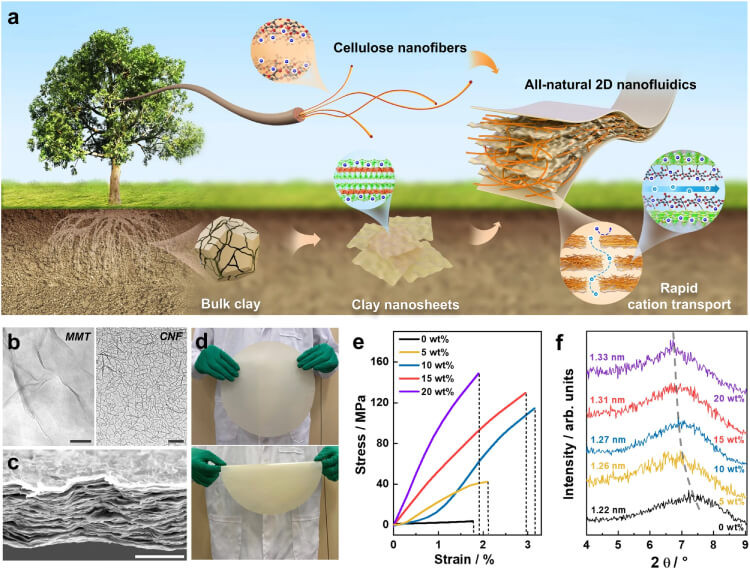2D Membranes Become Efficient Osmotic Energy Harvesters
Technical Analysis | 10-06-2024 | By Liam Critchley

New renewable energy solutions are being sought to transition away from fossil fuels. While wind and solar are the most prominent solutions with the most maturation, many other solutions are emerging that can support larger renewable energy harvesting technologies. One of these is osmotic energy harvesters that can generate renewable energy from the mixing of seawater and freshwater with a salinity gradient.
Among osmotic energy harvesters, membrane-based reverse electrodialysis (RED) is a prominent technology that can directly generate electricity from osmotic energy using a net ion flux that stems from ion concentration diffusion across an ion-selective membrane. Developing high-performance membranes is critical to achieving an efficient osmotic energy harvesting operation.
Key Things to Know
- Integration with Renewable Energy Systems: Recent advancements show that combining nanofluidics with renewable energy technologies can significantly boost energy conversion efficiency by optimising ion transport and selectivity.
- Sustainable and Cost-Effective Materials: Using naturally occurring materials like clay and cellulose in nanofluidics aligns with sustainability goals and provides a cost-effective solution for large-scale energy harvesting applications.
- Enhanced Mechanical Strength and Ion Selectivity: Incorporating intercalated cellulose nanofibers within montmorillonite clay significantly reduces energy losses, improves structural reinforcement, and enhances ion transport efficiency, leading to higher osmotic power output.
- Long-Term Stability and Environmental Benefits: All-natural 2D nanofluidic membranes not only offer superior performance in osmotic energy harvesting but also present a sustainable approach with lower resource consumption, reduced greenhouse gas emissions, and lower production costs compared to conventional materials.
Advancements in Membrane Technology for Osmotic Energy Harvesting
According to recent studies, the integration of nanofluidics with renewable energy systems has the potential to significantly enhance energy conversion efficiency. These systems utilise the unique properties of nanomaterials to optimise ion transport and selectivity, which are crucial for maximising osmotic energy generation. Incorporating naturally occurring materials like clay not only aligns with sustainability goals but also provides a cost-effective solution for large-scale applications.
2D nanofluidics—particularly those based on naturally abundant clay—are seen as potential candidates for harvesting osmotic energy, especially as natural materials are a lot more sustainable and play into the wider green and renewable ethos of renewable energy harvesting. While there is a lot of potential for these 2D materials, efforts so far have been plagued by a lack of surface charge and mechanical strength, which has meant that producing a large osmotic power output over a long time frame has been challenging, but researchers have set out to change this.
Recent advancements in nanofluidics have demonstrated that combining clay-based materials with recycled cellulose can overcome these challenges. For instance, a study highlighted the successful use of montmorillonite clay nanosheets intercalated with cellulose nanofibers to create a robust and efficient osmotic energy harvester. This innovation not only improves mechanical strength and stability but also enhances ion selectivity and transport efficiency.
To better understand the structure and composition of the innovative nanofluidic membranes, researchers have provided detailed schematic and microscopic images. These illustrations showcase the assembly process, material properties, and structural integrity of the montmorillonite (MMT) and cellulose nanofiber (CNF) based 2D nanofluidic membranes, highlighting their potential for efficient and sustainable osmotic energy harvesting.

a) Schematic diagram illustrating the assembly of natural montmorillonite (MMT) and natural cellulose nanofibers (CNFs) into a large-area 2D-NNF membrane with selective and fast cation transport nanochannels. The inset picture of CNF (left) shows C (dark), O (red), and H (white); the inset picture of clay nanosheets (left) displays Si (green), O (yellow), and Al (red); and the dark blue spheres (left) indicate negatively charged particles, while the light blue spheres (right) indicate cations. b) TEM images of the prepared MMT nanosheets (left) and CNFs (right). Scale bars: 200 nm. c) Cross-sectional SEM image of the 2D-NNF with 10% CNF content, showing an ordered lamellar structure. Scale bar: 5 µm. d) Photographs depicting the flat state (upper) and bent state (bottom) of a robust large-scale 2D-NNF membrane (φ 30 cm). e) Tensile stress-strain curves of the 2D-NNF with different CNF contents. f) SAXRD patterns of the 2D-NNF with various CNF contents. The dotted line indicates the layer spacing (left) gradually increasing with the content (right) of intercalated CNFs. Source data are provided as a Source Data file.
The Potential of Natural 2D Nanofluidics
In recent years, nanofluidics with nanoscale channels have been used to create ion-selective membranes to regulate ion transport—through strong ion selectivity and high ion flux—and have been designed with dense nanochannels that have a high surface charge. Additionally, nanofluidics can exhibit ion rectification mechanisms by controlling the shape and surface charge of the nanochannel, which reduces ionic concentration polarisation and enhances osmotic energy harvesting—so there’s a lot of potential for creating tuneable harvesting devices.
2D nanofluidics are multi-layered membranes that are composed of self-assembled 2D materials layers, where the space between the layers becomes a nanochannel for selective ion transport. In recent years, a number of classical 2D materials have been used to construct these systems, including graphene oxide, MXenes, and boron nitride. Many of these have shown good potential and have exhibited the capacity to harvest osmotic energy, but the fabrication methods have been a challenge for large-scale implementation. Additionally, because there’s a strong focus on sustainability for osmotic energy harvesters, the use of harsh chemicals during the fabrication process puts some people off.
Challenges and Advantages of Using Natural Raw Materials in 2D Nanofluidics
For both large-scale commercialisation and sustainable design, using natural raw materials is seen as a promising alternative for constructing 2D nanofluidic devices. Natural clay is a carrier of 2D material layers, which is in abundance and more environmentally friendly than traditional 2D materials. Many natural clays have layered crystal structures that are stabilised by weak van der Waals forces, so a few layers of 2D nanosheets can be easily obtained from clays using ion exchange exfoliation processes. Creating 2D nanofluidics in this way offers a more sustainable, cheaper, and eco-friendly route to osmotic energy harvesting operations.
A key development in this field is the creation of all-natural nanofluidic membranes that can sustainably harvest osmotic energy. By leveraging the inherent properties of materials like montmorillonite and cellulose, researchers have developed scalable and environmentally friendly methods to produce high-performance nanofluidic devices. These advancements are set to transform the approach to renewable energy generation, making it more accessible and sustainable.
Researchers Create All-Natural Osmotic Energy Harvester
Natural clay materials such as vermiculite and montmorillonite (MMT) can be developed into 2D nanofluidics for harvesting osmotic power. This route tends to produce clay nanosheets that have a low mechanical strength, which limits their durability and energy output. However, natural clay 2D nanosheets, such as MMT nanosheets, can be strengthened by intercalating nanofibers between the layers.
One of the best intercalation nanofibers for MMT is cellulose nanofibers (CNF). Beyond being another natural material that is in abundance, it is cheap (roughly 20 USD per kg), and it has a high intrinsic strength that enables it to reinforce the MMT layers in a nanofluidic membrane. There’s also the potential to further stabilise the nanosheets by bridging the oxygen groups on the nanofibers with the nanosheets to interlock the configurations and make them more robust.
Furthermore, the introduction of intercalated cellulose nanofibers within the montmorillonite matrix significantly reduces energy losses associated with ion transport. This intercalation not only provides structural reinforcement but also creates an optimal pathway for ions, thereby enhancing the overall efficiency of the energy harvesting process. These innovative approaches are paving the way for the next generation of sustainable energy solutions.
Innovative Approaches in Nanofluidics for Enhanced Energy Harvesting
Researchers have now created an all-natural 2D nanofluidic osmotic energy harvesting generator using CNF-stabilised MMT nanosheets. The sheets are stacked on top of each other and locked in place by the CNFs—which were obtained from wood. The nanofluidics developed by the team had confined interlamellar channels with a lot of surface and space-negative charges that generated a strong electrostatic field in the nanochannels. This enabled fast and selective cation transport in the membrane—the fundamental basis of osmotic energy harvesting. The interlocking of the MMT layers with the CNF also contributed to a high mechanical strength that promotes long-term stability. The membrane thickness was also found to be tuneable and could be controlled to as low as 5 microns, which created a low internal resistance that promoted a higher osmotic power output.
Additionally, the ability to fine-tune membrane thickness is a critical factor in optimising energy output. Thinner membranes reduce internal resistance, facilitating faster ion transport and higher power generation. This flexibility in design ensures that the nanofluidic devices can be tailored to meet specific energy requirements, further enhancing their practicality and efficiency in real-world applications.
As an osmotic energy harvester, the 2D nanofluidic generator obtained an osmotic power output of 8.61 W m-2 when mixing artificial seawater and river water and is higher than other 2D nanofluidics that have been attempted (which tend to be around 5 W m-2 currently).
The area of the nanofluidic membrane was also enlarged to 700 cm2, and tests were carried out at several different sites on the membrane to check that the membrane performance was uniform. Across all the localised test, the average power output stayed at an average of 8.36 W m-2, showing that there’s a lot of uniformity across larger scale membranes and very little disparity. It was also found that the membranes could maintain a long-term stability beyond 30 days due to this uniformity.
Moreover, the stability and uniformity of these large-scale membranes are crucial for their long-term application in renewable energy systems. Consistent performance across extensive membrane areas ensures reliable energy output, making them suitable for continuous and large-scale energy harvesting operations. This robustness is essential for practical deployment in various environmental conditions.
A detailed life cycle assessment was also performed on the nanofluidic membrane, which showed that the membrane has an advantageous resource consumption, greenhouse gas emissions (GHGs), and production costs compared to conventional 2D nanofluidics. The development of using all-natural materials to create 2D nanofluidics offers a much more sustainable approach for large-scale and efficient osmotic energy harvesting.
The integration of these innovative materials and processes not only advances the field of osmotic energy harvesting but also sets a new standard for sustainability in renewable energy technologies. By utilising all-natural, abundant materials and environmentally friendly production methods, this approach significantly reduces the environmental impact and promotes a circular economy. This holistic strategy ensures that the advancements in energy technology contribute positively to both the energy sector and the environment.
Reference:

